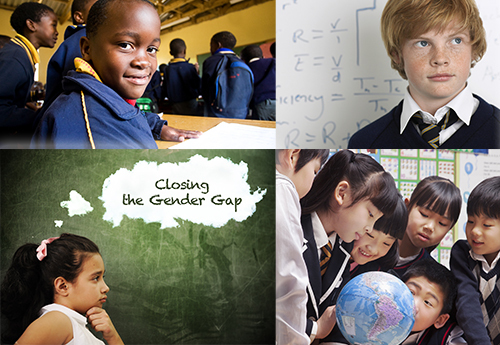The OECD's PISA report, The ABC of Gender Equality in Education, featured in The Global Search for Education: Education and Gender, illustrated that the gender gap cuts both ways - boys' and girls' attitudes to learning, their behavior in school and their self-confidence impacted their abilities as students.
Today in The Global Search for Education, our Top Global Teacher Bloggers will share their answer to this question: "What are the best examples you have seen of teachers closing the gender gap in education?"
The question stirred up some controversy among our experts. The topic itself is significant because the global gender gap across health, education, economic opportunity and politics has closed by only 4% in the past 10 years, with the economic gap closing by just 3%. On the current path we are on, it may take another 118 years to close the gap completely. The question is controversial because in many countries--in particular English-speaking, developed countries--it is actually young boys who are falling behind in education.
Our Global Teacher Bloggers are pioneers and innovators in fields such as technology integration, mathematics coaching, special needs education, science instruction, and gender equity. They have founded schools, written curricula, and led classrooms in 13 different countries that stretch across every populated continent on earth. These teachers empower and enrich the lives of young people from nearly every background imaginable.
In her blog post, Elisa Guerra (@ElisaGuerraCruz) highlights the real difficultly of solving the problem: "Even good teachers are frequently caught upon stereotypes. Closing the gender gap in education requires serious, conscious effort." Teachers are important role models in the lives of young people. If teachers are not aware of gender typecasts, they can just as easily reinforce the status quo as they can weaken it. Therefore, it's of crucial importance to "provide positive role models of women in the sciences and men in the humanities, both in history and today..." so that students do not feel that they are socially obligated to fit in any particular gender role. Read More.
This idea is echoed by Vicki Davis (@coolcatteacher). She notes that, "...it is often an observant teacher coupled with an open minded parent that makes a huge difference in the path girls choose. It isn't about forcing her down a path, but letting her see as many options as possible that makes the difference in the end." Read More.
Miriam Mason-Sesay (@MiriamMasonSesa) teaches in Sierra Leone where the gender gap is very serious. Young women are rarely brought up in a way that engenders hope regarding their academic prospects. It's essential to challenge social forces that make girls feel like they are not strong, intelligent and capable members of society. "The idea is to catch them young and to teach them their value and make sure that the negative messages never get a chance to take hold." Read More.
Rashmi Kathuria (@rashkath), who teaches in India, feels similarly. It's essential to provide real opportunities for women to prove to others and to themselves their true potential. That's why she strongly encourages women to participate in programs like inter-school math competitions. "Promoting gender equity in the classroom involves not only providing equal resources to both girls and boys but also providing equal opportunities to learn." Read More.
Maarit Rossi (@pathstomath) from Finland asserts that the way to close the gender gap is to have students participate in activities across gender lines. "It is important that the schools deliberately mix the genders in the classrooms, train students to work in diverse groups and so support the growth of equality and understanding." Students at certain ages are often most comfortable being in groups that are divided by gender. Allowing for these divisions can be damaging. Young people might grow to believe in narrow gender roles because they don't yet understand the deep similarities in capacities that humans share regardless of gender. Read More.
Nadia Lopez (@TheLopezEffect) emphasizes what works at Mott Hall Bridges Academy, the school she founded. In order to close the gender divide in science, girls should be actively engaged in the magic of science. This not only includes participation in traditional lab experiments but also exposure to the many practical applications of science, including horticulture and animal science. "When opportunities are created for our girls to explore the world of science around them and encourage teachers to be creative in their practices, we then have the power to eliminate the gaps that exist between genders." Read More.
In his blog post, Warren Sparrow (@wsparrowsa) brings to light a very different problem: young boys are falling behind in many countries. "A strange phenomenon in South Africa is that there are more boys than girls in primary school, but this gets reversed in high school and tertiary institutions. Where do all the boys go?" This question is one shared across many English-speaking countries: Why is it that boys seem to be falling behind in education? Read More.
Adam Steiner (@steineredtech) recommends the blog post of social studies teacher Jay Barry, who notes the trend that "many boys stop reading for pleasure in middle school and those that are reading often choose books that do not challenge them as readers." He believes that a disturbing cultural trend is developing across America where men are not taught the value of education. They are not encouraged to be thoughtful or scholarly because it's not "cool" or "tough". This growing cultural trend is detrimental to the educational opportunities of young boys. Read More.
Pauline Hawkins (@PaulineDHawkins) pushes this line of thought even further. "In general, female students are able to sit for longer periods of time without breaks; they are less likely to interrupt teachers in a classroom; and they read more than males do. In other words, the current classroom is catering to female students and punishing male students." She believes that testing culture and the traditional styles of learning where children sit silently and listen across the room is more favorable to girls. Read More.
Richard Wells (@EduWells) suggests that this can be remedied by "flipped teaching or project-based learning. This is connected to boys needing to be doing rather receiving. Most boys need to be active learners". By engaging boys rather than lecturing them might help reverse the trend of male underachievement. Read More.
Craig Kemp (@mrkempnz) says one of the reasons he got into education was "to change the typical stereotypes around boys in education." He believes boys in his school system need "a positive male role model in their life" and "need to be engaged in a variety of ways". This month, Craig shares 5 ways to engage boys in classrooms to help close the gender gap. Read More.
The Top Global Teacher Bloggers is a monthly series where educators across the globe offer experienced yet unique takes on today's most important topics. CMRubinWorld utilizes the platform to propagate the voices of the most indispensable people of our learning institutions, teachers.

Top Row, left to right: Adam Steiner, Santhi Karamcheti, Pauline Hawkins
2nd Row: Elisa Guerra, Humaira Bachal, C. M. Rubin, Todd Finley,
Warren Sparrow
3rd Row: Nadia Lopez, Katherine Franco Cardernas, Craig Kemp,
Rashmi Kathuria, Maarit Rossi
Bottom Row: Dana Narvaisa, Richard Wells, Vicki Davis, Miriam Mason-Sesay
(All photos are courtesy of CMRubinWorld)
Join me and globally renowned thought leaders including Sir Michael Barber (UK), Dr. Michael Block (U.S.), Dr. Leon Botstein (U.S.), Professor Clay Christensen (U.S.), Dr. Linda Darling-Hammond (U.S.), Dr. MadhavChavan (India), Professor Michael Fullan (Canada), Professor Howard Gardner (U.S.), Professor Andy Hargreaves (U.S.), Professor Yvonne Hellman (The Netherlands), Professor Kristin Helstad (Norway), Jean Hendrickson (U.S.), Professor Rose Hipkins (New Zealand), Professor Cornelia Hoogland (Canada), Honourable Jeff Johnson (Canada), Mme. Chantal Kaufmann (Belgium), Dr. EijaKauppinen (Finland), State Secretary TapioKosunen (Finland), Professor Dominique Lafontaine (Belgium), Professor Hugh Lauder (UK), Lord Ken Macdonald (UK), Professor Geoff Masters (Australia), Professor Barry McGaw (Australia), Shiv Nadar (India), Professor R. Natarajan (India), Dr. Pak Tee Ng (Singapore), Dr. Denise Pope (US), Sridhar Rajagopalan (India), Dr. Diane Ravitch (U.S.), Richard Wilson Riley (U.S.), Sir Ken Robinson (UK), Professor Pasi Sahlberg (Finland), Professor Manabu Sato (Japan), Andreas Schleicher (PISA, OECD), Dr. Anthony Seldon (UK), Dr. David Shaffer (U.S.), Dr. Kirsten Sivesind (Norway), Chancellor Stephen Spahn (U.S.), Yves Theze (LyceeFrancais U.S.), Professor Charles Ungerleider (Canada), Professor Tony Wagner (U.S.), Sir David Watson (UK), Professor Dylan Wiliam (UK), Dr. Mark Wormald (UK), Professor Theo Wubbels (The Netherlands), Professor Michael Young (UK), and Professor Minxuan Zhang (China) as they explore the big picture education questions that all nations face today.
The Global Search for Education Community Page
C. M. Rubin is the author of two widely read online series for which she received a 2011 Upton Sinclair award, "The Global Search for Education" and "How Will We Read?" She is also the author of three bestselling books, including The Real Alice in Wonderland, is the publisher of CMRubinWorld, and is a Disruptor Foundation Fellow.

